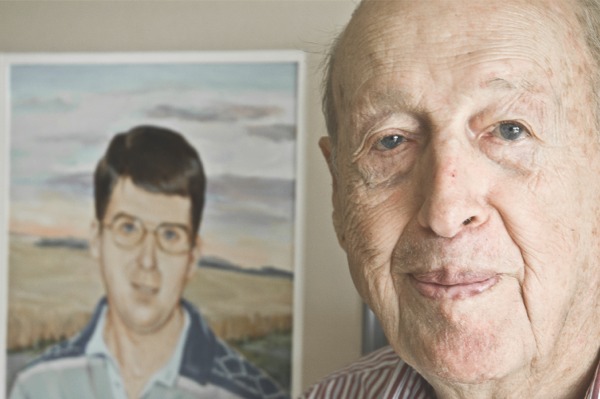On June 23, 1972, Martin J. McNally boarded American Airlines Flight 119 from St. Louis to Tulsa. His goal: to make $502,500 that day. His means: a submachine gun smuggled onboard in a violin case.
McNally, whose plan was considered the ninth “copycat” response to that hijacker D.B. Cooper, forced the plane’s landing where he received his money and parachutes. After demanding a second flight, McNally and the crew boarded and flew northeast.

Leroy “Berk” Berkebile stands before a picture of his son, who passed away at age 34, and was a pilot just like his father. (Photo by Chris LaPelusa/Sun Day)
If McNally was hoping to intimidate this second pilot, he had no idea what he was in for. This plane was piloted by Leroy “Berk” Berkebile and an FBI agent in pilot’s clothes.
McNally walked up to the cockpit armed – his finger never leaving the trigger. The agent/copilot, armed with a pistol, suggested he should shoot the hijacker, but Berkebile advised against it.
“I said, ‘No… his [first] natural reaction was to pull the trigger on the machine gun,'” he said.
So Berkebile kept his nerve, landing the plane at O’Hare airport after McNally parachuted off the plane. McNally’s plan was foiled: he lost the money and gun while falling, and the two items, which were discovered by farmers near Peru, Ind. yielded fingerprints that led to his arrest. McNally was sentenced to two life sentences in federal prison.
Looking back on that day, Berkebile called it “just another day on the job.” Perhaps it’s easy for him to say that because his 29-year career with American Airlines produced its share of tense moments, like a fireball that ripped through the cabin after Berkebile’s plane had been struck by lightning.
Credit for Berkebile’s calm may also go to his military background. A veteran of three wars, Berkebile, like many of his generation, felt the call to serve after witnessing a tragic attack on American soil.
Berkebile was flying a Piper Cub Coupe on December 7, 1941 and heard the news from those in the control deck listening to the radio.
“They started saying about how the Japanese attacked us, and they said ‘Pearl Harbor,’ and nobody knew where Pearl Harbor was until the announcer said, ‘Hawaii,'” Berkebile said.
Berkebile would make his mark on that war, enlisting in the Navy and receiving advanced training in Pensacola, Fla. As a bomber, he fought in the Pacific Theater, primarily in the Philippine Sea.
Following the war, Berkebile returned home and met a man from Rockford in the crop dusting business. His company had a contract with Del Monte Foods, and Berkebile became a one-third partner.
As the shadow of the Cold War crept across the world, American troops were called into action, this time into North Korea. Berkebile again took to the skies to serve his country.
“It was more precise,” Berkebile said in comparing his experience in the Korean War to World War II.
So precise, in fact, that Berkebile would drop bombs in between rails when bombing the North Korean railroads.
“I remember seeing pictures of those locomotives in Europe; when the guys would strike them, they’d blow up,” he said. “I tried that in Korea, and they didn’t blow up, just the steam leaked out. The train would stop because the locomotive would no longer supply power. But then I found out later, in Europe they’re using high pressure steam; in Korea they’re using low pressure.”
It was in Korea that Berkebile would receive his highest military honor: the Distinguished Flying Cross.
Berkebile was strike leader for Flight Squadron 92, a group of 22 fighter jet and attack planes targeting a heavily defended Korean supply area. Berkebile and his squadron took out all anti-aircraft positions while attacking the main target with precision timing and accuracy.
He also led preceding attacks on other targets in the area and even guarded a photographic plane to get evidence of the attack.
The attack, which destroyed 42 enemy buildings and sustained no U.S. aircraft losses, was considered a linchpin in the war and earned Berkebile the medal.
Upon returning home, Berkebile again worked in crop dusting and again enlisted as America entered combat in Vietnam.
This time, Berkebile flew on supply missions, loading up cargo and personnel in California, stopping at Midway Island to refuel, then continuing on to Guam. After dark, he and other pilots would fly into Vietnam and unload the supplies.
Berkebile’s two years in Vietnam would mark the end of his active Navy duty. Returning to crop dusting would sow the seeds for his commercial flight career. When an employee asked for the day off to apply for a job at American Airlines, Berkebile flew with him and filled out an application. They were both hired.
Berkebile’s achievements continued on: he would become Area Director of Flight for American, he formed the Naval Air Reserves Jet Aerobatic team, and he taught at the Navy’s famed Top Gun school. Berkebile recalled with glee his first supersonic flight in 1954. He was flying over his old hometown and wanted to give them something special.
“So I gave them a boom,” he said.
As if that decorated career were not enough, upon retiring from commercial flight, Berkebile got to chauffer an American icon through the clouds: Frank Sinatra.
“He was a good guy…very friendly,” he said.
In the 1980s, Sinatra was performing at casinos and Berkebile flew him and his family to those destinations.
“One time we were standing outside the airplane and his people were unloading their stuff at Palm Springs,” Berkebile said. “And he said, ‘I really like Monday Night Football; I never miss it.'”
Naturally, Berkebile would be Sinatra’s pilot of choice to take him to see four Super Bowls.
Though now grounded, Berkebile hasn experienced well over a lifetime’s worth of memories in the sky. His flight log clocks in 33,000 flight hours with Australia as his favorite destination, and he has flown 108 planes, with the Stearman as his favorite one.




